 All Our Tours
All Our Tours
Written by: Vicky Nguyen
Updated date:23/08/2025
Hello, I’m Vicky! As a passionate travel enthusiast and tour planner at Asia Viva Travel, I’ve gathered extensive experience traveling across Vietnam and other captivating destinations in Southeast Asia. Now, I’m thrilled to share these adventures with you through my blog. From my journeys, I’ve gained a deep understanding of the unique cultures, hidden gems, and unforgettable experiences that this region has to offer. My goal is to bring you authentic and practical insights to help you design your own remarkable adventures. Join me, and let’s discover these extraordinary places together!
Contents
Amid the rush of an overland journey through Southeast Asia, Pakbeng feels like a gentle pause button on the map. It’s not a place of neon lights or bustling streets, but one where you hear the soft splash of paddles on water, watch morning mist curl above the Mekong, and let time itself slow down. That’s why Pakbeng becomes more than just a stopover,it becomes part of the journey you’ll never forget.
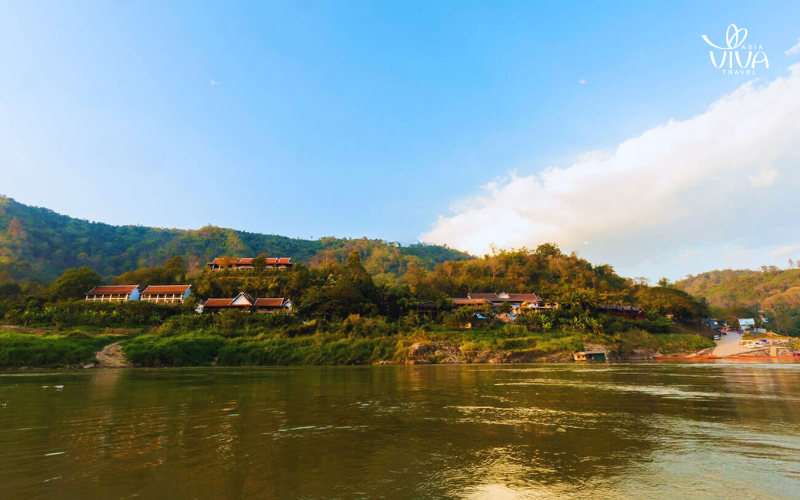
Morning calm over the Mekong River in Pakbeng
Pakbeng is a small riverside town in Oudomxay Province, northern Laos, perched on the banks of the mighty Mekong River. It sits exactly halfway along the route between Luang Prabang and Huay Xai, the gateway for travelers crossing between Laos and Thailand via the Chiang Khong – Huay Xai border. While it’s not a bustling tourist hub, Pakbeng exudes a quiet charm that perfectly embodies the spirit of slow travel. Many visitors arrive aboard the slow boat, drifting along the Mekong while soaking in views of lush green mountains, peaceful riverside villages, and the timeless flow of the river itself. This tranquil atmosphere often tempts travelers to linger longer, turning what was meant to be just an overnight stop into a memorable stay.
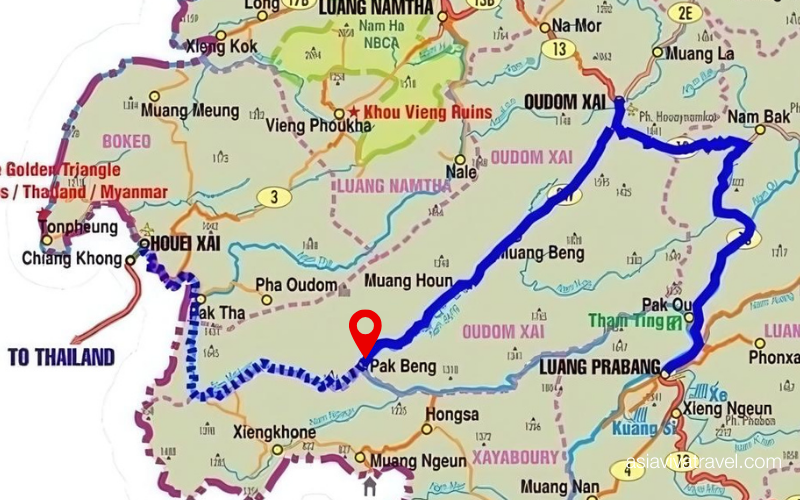
Pakbeng’s strategic location on the Mekong route
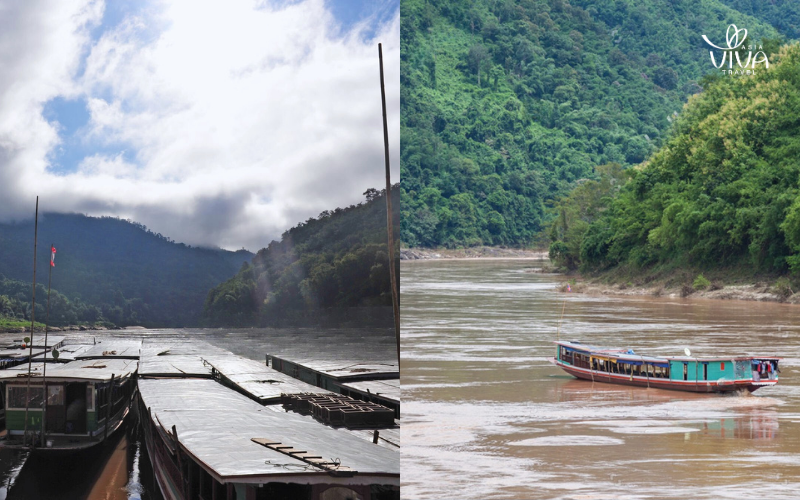
Dry vs rainy season in Pakbeng
With its tropical monsoon climate, Pakbeng experiences two distinct seasons: the dry season and the rainy season. Temperatures can drop to around 18°C (64°F) during the cooler months from December to February, while the hottest period, from March to May, sees highs of 30–31°C (86–88°F).
The dry season runs from November to April and is the best time to visit with sunny skies, comfortable temperatures, and safe, scenic slow boat journeys along the Mekong. The rainy season, from May to October, brings heavy downpours and high river levels, making boat travel potentially dangerous. Travelers venturing here during this time should monitor weather forecasts closely.
One unique aspect of Pakbeng’s climate is how quickly the seasons shift. In just a few weeks between late October and late November, the town transitions from rainy to dry. The river recedes, the sun lingers longer, and mornings turn refreshingly cool – painting a picture-perfect backdrop for a Mekong river journey.
With its tropical monsoon climate, Pakbeng experiences two distinct seasons: the dry season and the rainy season. Temperatures can drop to around 18°C (64°F) during the cooler months from December to February, while the hottest period, from March to May, sees highs of 30 – 31°C (86 – 88°F).
The dry season runs from November to April and is the best time to visit – sunny skies, comfortable temperatures, and safe, scenic slow boat journeys along the Mekong. The rainy season, from May to October, brings heavy downpours and high river levels, making boat travel potentially dangerous. Travelers venturing here during this time should monitor weather forecasts closely.
One unique aspect of Pakbeng’s climate is how quickly the seasons shift. In just a few weeks between late October and late November, the town transitions from rainy to dry. The river recedes, the sun lingers longer, and mornings turn refreshingly cool – painting a picture-perfect backdrop for a Mekong river journey.
Today, getting to Pakbeng is quite easy for tourists with many options ranging from slow boats and ferries along the Mekong River to buses, private cars, and even domestic flights. For an unforgettable experience, we recommend the slow boat- a scenic cruise along the Mekong with lush riverbanks on both sides, it’s perfect for tourists to capture the region’s slow-travel charm.
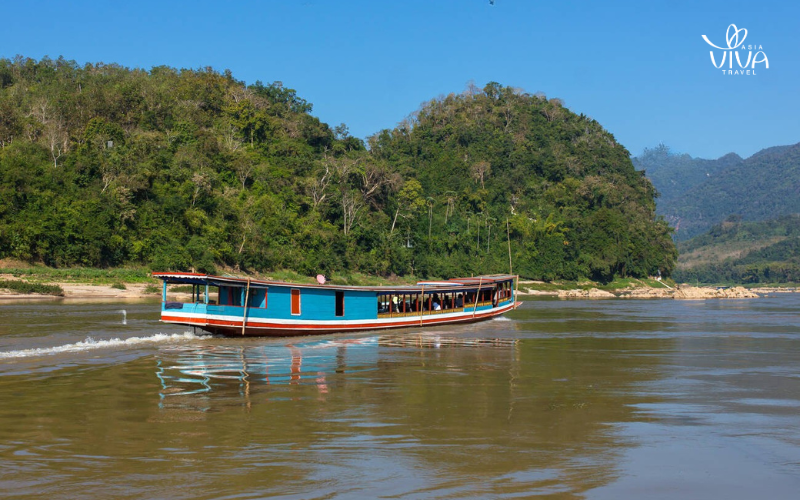
Slow boat journey to Pakbeng
From Luang Prabang to Pakbeng, the most scenic way is by slow boat upstream along the Mekong, a 7–8 hour journey that typically departs around 8 a.m. The ride embodies true “slow travel”: wooden seats, riverside fishing villages, limestone cliffs, and lush jungle rolling past at a leisurely pace. Tickets cost about $12–15 and can be purchased at the pier or through local agencies.
If you don;t want to travel by slow boat, speedboats are also available, cutting the trip to 3-4 hours, but they’re not widely recommended due to safety and comfort concerns. Alternatively, travelers can opt for a bus ride, it’s faster at around 5 hours and slightly more budget-friendly, with tickets from $18.
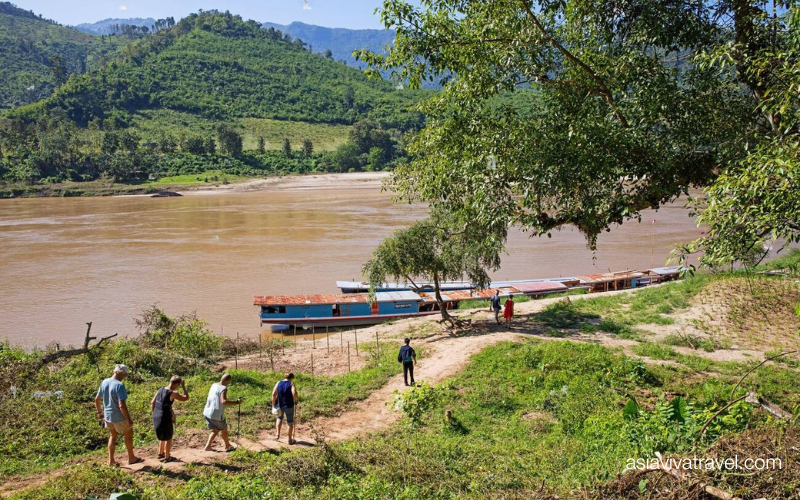
Upstream cruise from Luang Prabang
The Huay Xai to Pakbeng route is the most popular choice for travelers crossing from Thailand into Laos. Most begin in Bangkok, fly or bus to Chiang Rai, then continue by road to Chiang Khong. After exiting Thailand, travellers’ll cross the Fourth Thai–Lao Friendship Bridge into Huay Xai. Once immigration formalities are done, tickets for the slow boat can be purchased at the riverside pier.
From Huay Xai, boats depart in the morning and take about 7–8 hours to reach Pakbeng. Expect a true “day cruise” experience: simple wooden seating, ever-changing riverside landscapes, and a basic lunch of rice, vegetables, and Mekong fish served on board.
This leg is Day 1 of the two-day Mekong journey to Luang Prabang, with Pakbeng as the overnight stop. More than just a transit point, it’s a welcome pause to rest, recharge, and savor the slow rhythm of the river before continuing downstream on Day 2.
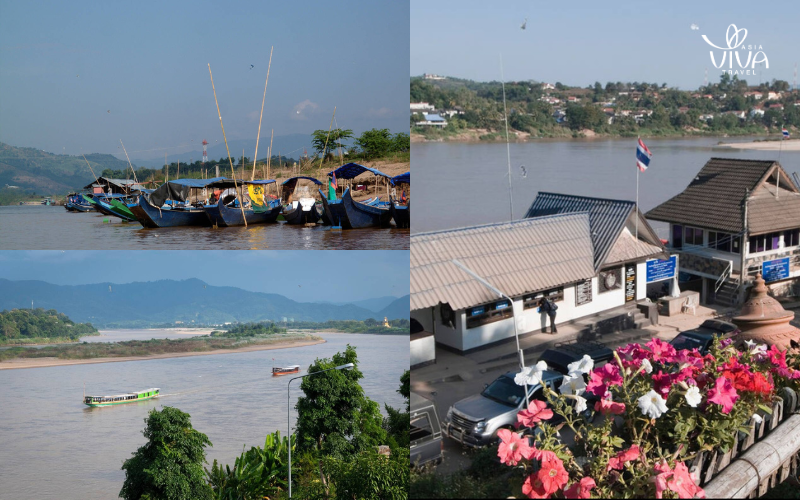
Crossing from Thailand to Laos via Huay Xai
It takes about 3–4 hour drive from Oudomxay to Pakbeng, making it the quickest route compared to other options. Buses and shared vans run the route, though schedules can be irregular, offering travelers a glimpse of rural northern Laos along the way.
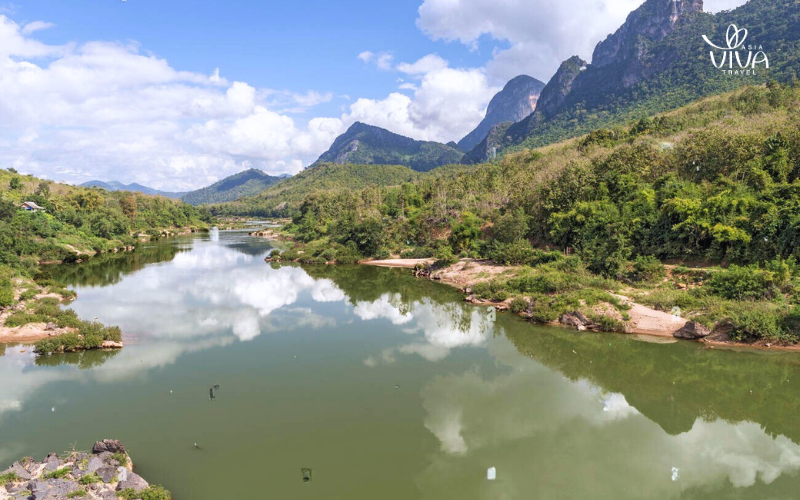
Scenic road from Oudomxay to Pakbeng
Travel Tips for Getting to Pakbeng
– Tickets: Boat and bus tickets are best purchased through local travel agencies or directly at your guesthouse. Online booking is still limited, but travelers rarely have trouble finding tickets, as they’re sold daily at piers and bus stations. Just be sure to arrive early, as most departures leave around 8 a.m.
– Timing: Plan to be at the pier or station well before departure – both to secure your ticket and to settle in comfortably.
– Onboard Comfort: Services on boats and buses are basic. Bring snacks, bottled water, and something to keep you entertained during the long ride.
– Clothing: Pack light but flexible – a jacket for cool mornings on the river, breathable clothes for hot afternoons, and rain gear if you’re traveling in the wet season.
Though Pakbeng is often seen as just a stopover town, it offers more than a place to rest between river journeys. Depending on your schedule, you’ll find a variety of experiences that showcase local culture, riverside nature, and eco-friendly tourism. From hilltop temples to elephant sanctuaries, quiet museums to Mekong viewpoints, Pakbeng has a handful of gems worth exploring.
Most attractions are small-scale and easy to reach, with visits ranging from an hour to half a day. This makes it simple to tailor your stop – whether you’re just passing through overnight or choosing to slow down and stay longer.
For travelers staying overnight in town, the Pakbeng Viewpoint is a rewarding walk that starts right from the village center. The trail winds through quiet neighborhoods, from past wooden houses, a small school to village life before climbing to a vantage point overlooking the Mekong River and the surrounding hills. From here, visitors’ll see the entire town laid out below, framed by the broad river and layers of green mountains.
A few things to note: the viewpoint isn’t marked on Google Maps, so it’s best to ask locals for directions or use alternative mapping apps. Parts of the path include a short but steep climb, though later sections are paved for safety. The best time to visit here is sunrise or sunset with amazing landscapes. At dawn, the valley is often veiled in morning mist, while sunset brings warm golden light reflecting on the Mekong – both moments capturing Pakbeng’s tranquil spirit at its best.
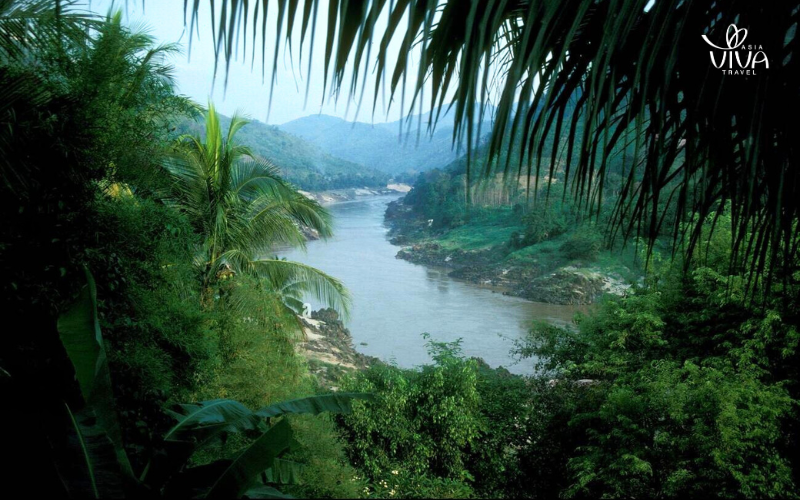
Panoramic view of Pakbeng
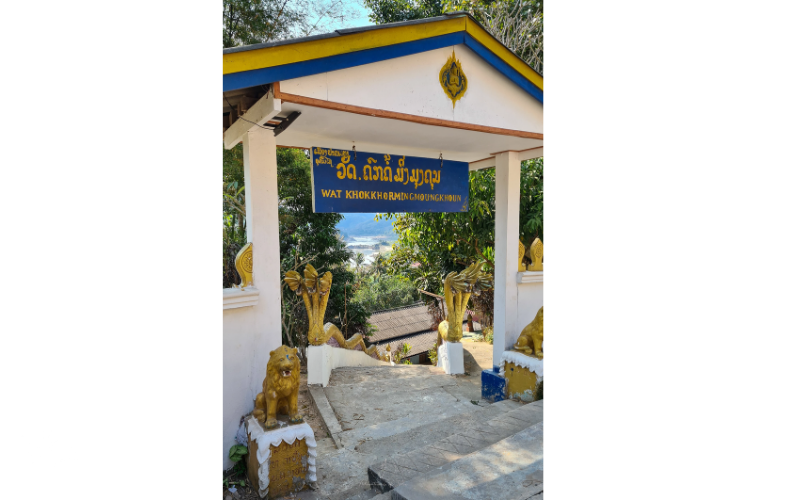
Wat Khokkhormingmoungkhoun temple overlooking the Mekong
Just a short walk from the Pakbeng Viewpoint lies Wat Khokkhormingmoungkhoun, a serene hilltop temple that overlooks both the town and the Mekong River below. This centuries-old site is rarely crowded, offering a quiet atmosphere where visitors can soak in the rhythm of Buddhist life in rural Laos.
For American travelers with a love of photography, the temple’s vantage point provides striking angles of the river and surrounding hills. It’s also an inviting place to learn more about Lao Buddhism and local spiritual traditions.
Tip: As you may be visiting directly after the viewpoint, it’s an easy stop on the same route. Please remember to dress modestly – covering shoulders and knees out of respect for the temple and its monks.
For many visitors, Mekong Elephant Park is the highlight of a stay in Pakbeng. Unlike traditional elephant camps, this ethical sanctuary focuses on protection and conservation – there is no riding. Instead, guests can feed the elephants, watch them bathe in the Mekong, and learn firsthand about the challenges of elephant conservation in Laos. By joining, travelers not only enjoy a unique experience but also directly support the care and well-being of these gentle giants through entry fees and donations.
Located across the river from the main town, the park is accessible by a short boat ride, followed by a walk through riverside paths. It’s about a 10-15 minute transfer from the town center, but the visit itself usually takes half a day, making it a great choice if you have a full day to spend in Pakbeng.
This part open from 8L 30 a.m to 4:30 p.m and thee entrance fee is around $20–25 USD per adult, depending on the package (basic entry, feeding, or extended guided tours).
When visiting this park, tourists should wear comfortable clothes and sandals or walking shoes. You don’t mind getting wet – the highlight of the day is often splashing alongside the elephants in the river.
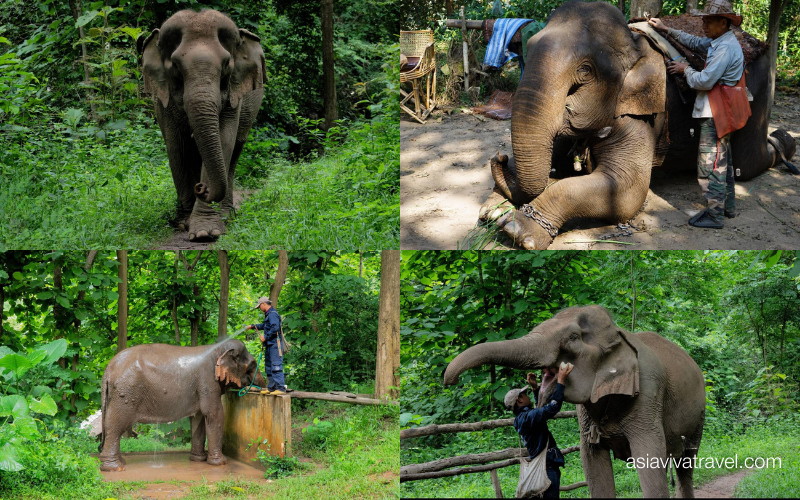
Ethical elephant encounters in Pakbeng
Though small in size, the Pakbeng Museum offers a fascinating window into the region’s history and culture. Its most notable exhibits showcase the traditional costumes, artifacts, and everyday tools of the ethnic groups who have lived along the Mekong for centuries. In less than an hour, visitors can gain a deeper appreciation for the diverse communities that make Pakbeng more than just a stopover – but a cultural crossroad on the river.
Conveniently located about 1 km from the town center, the museum can be reached on foot or by a short tuk-tuk ride.
Opening hours: 9:00 a.m. – 5:00 p.m. (closed during lunch from 12:00 – 1:00 p.m.)
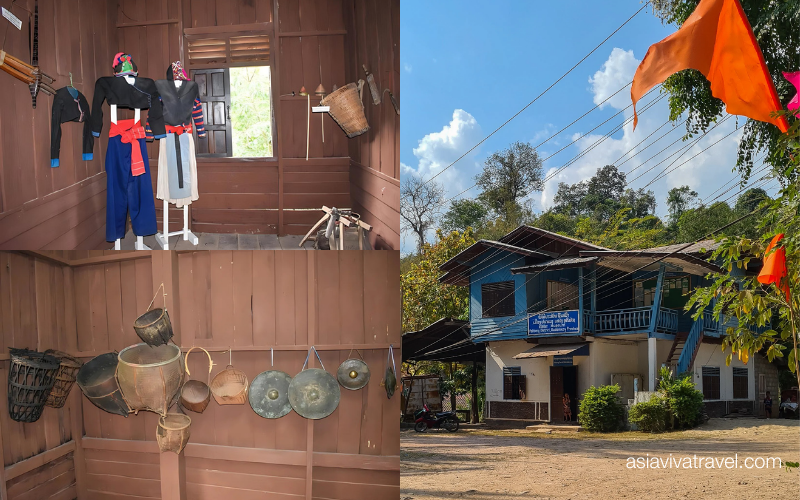
Cultural heritage at Pakbeng Museum
For travelers with limited time in Pakbeng, simply exploring the nearby villages can be rewarding. These are not staged cultural sites but living communities where daily life unfolds at a gentle pace – farmers tending fields, children walking to school, families preparing everyday meals and drinks. A highlight not to miss is sampling Lao Lao, the local rice whiskey, often shared with warm hospitality.
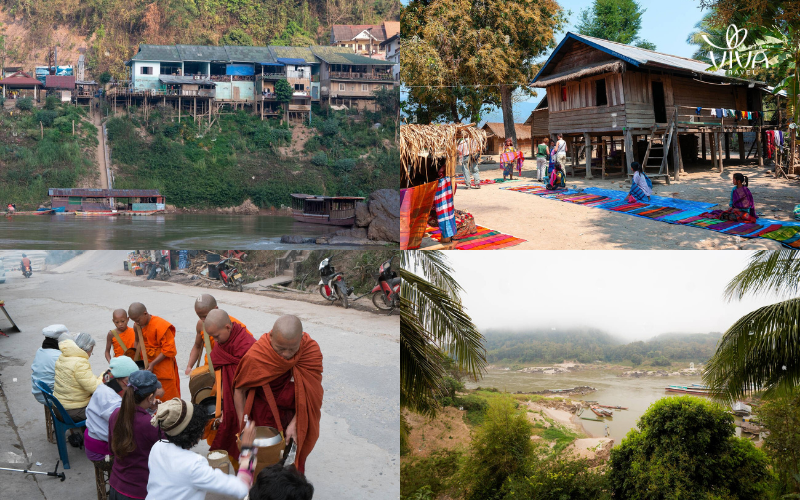
Everyday life in Pakbeng villages
Pakbeng is a small riverside town with many accommodation options cover a wide spectrum, catering to different budgets and travel styles:
– Luxury – Le Grand Pakbeng Resort
Perched above the Mekong, this upscale resort offers private bungalows with river views, an infinity pool, and full 4-star amenities. Ideal for travelers seeking comfort and a tranquil retreat after a long river journey.
– Mid-range – Sanctuary Pakbeng Lodge
An elegant eco-lodge that combines comfort with sustainability. Its riverside terraces and well-designed rooms make it a favorite for those who want a balance of nature, culture, and convenience.
– Budget – BKC Villa Pakbeng
Located close to the pier, this guesthouse is simple, affordable, and convenient — perfect for backpackers or travelers just spending one night in town before continuing their Mekong journey.
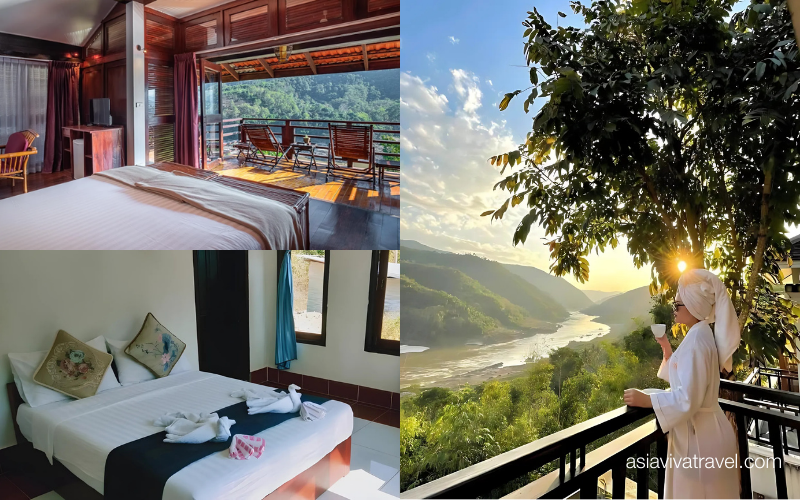
Accommodation options in Pakbeng: luxury to budget
Booking Tip: During the high season (November to February), accommodations fill up quickly. It’s best to reserve 1–2 months in advance. In addition, in fact, Pakbeng is originally a transit stop, so most of the accommodations here are opened by local people and the prices are very cheap. Some motels are not even on booking websites, but to ensure safety and quality, visitors can come directly to see the rooms, ask for prices and choose accommodation.
Consult with Asia Viva Travel for a curated itinerary and recommended stays suited to your budget.
Cuisine in Pakbeng reflects both the richness of the Mekong and the simplicity of Lao rural life. Here are some must-try dishes:
– Laap – the national dish of Laos, this minced meat salad mixed with fresh herbs and lime juice is refreshing yet full of flavor.
– Dishes with Mekong Fish – firm freshwater fish, either grilled to keep its juicy texture or steamed with vegetables, often served with local dips and side dishes.
– Sticky Rice (Khao Niew) – the staple of every Lao meal. What makes it special is not only the fragrant glutinous rice itself but also the traditional way of serving it in a handwoven bamboo basket.
– Lao-Lao Rice Whiskey – the local spirit made from fermented sticky rice, strong yet smooth, often shared in village gatherings and celebrations. This might be served in dinner, visitors can have an amazing experience by trying the home-made Lao Lao by locals in Pakbeng.
– Lao Crepe – a light, crispy street snack usually found at the night market, with a variety of sweet or savory fillings. This might be suitable for kids or anyone who loves to try the Asian version for crepes.
Where to eat in Pakbeng: For an authentic experience, try the central market of Pakbeng where locals gather to eat and shop. For more refined versions, the restaurants at Sanctuary Pakbeng Lodge or Le Grand Pakbeng Resort offer elevated presentations of these traditional dishes.

Traditional Lao cuisine in Pakbeng
Bring Cash (Kip or USD): While Pakbeng does have ATMs, they are few in number and not always reliable. It’s best to exchange money in Luang Prabang or before crossing the border to avoid inconvenience.
Connectivity: Wi-Fi is available at some guesthouses and cafes, but often slow. To stay connected and navigate easily, purchase a local SIM card with 4G data from providers like Unitel, Lao Telecom, or ETL. This will be especially useful since many locals speak only Lao.
Dress Smart: Pack versatile clothing suitable for both outdoor activities and cultural visits. When entering temples, ensure your attire is respectful: long pants or skirts covering the knees, and tops that cover the shoulders.
Book in Advance (Peak Season): Hotels and boats can fill up quickly during high season. Secure your accommodation and transport tickets 1–2 months ahead. For a hassle-free option, contact Asia Viva Travel for curated itineraries and confirmed bookings tailored to your budget.
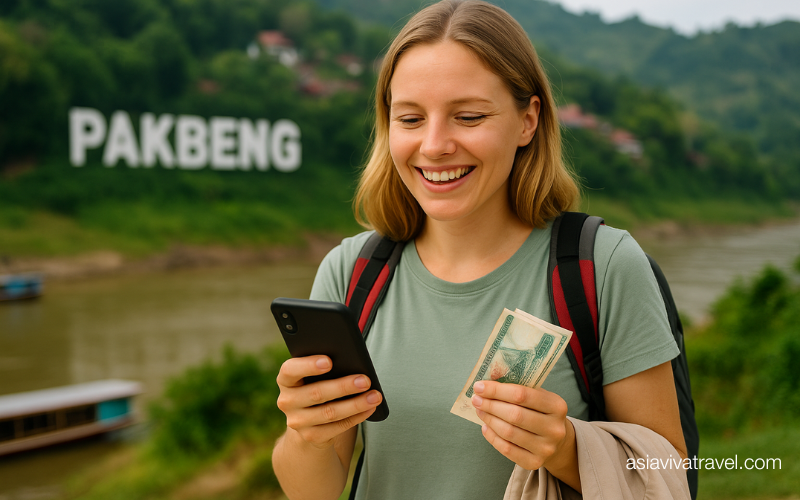
Smart travel tips for exploring Pakbeng
Travellers can also look for travel tips in destinations or cuisine that joined the route going to Pakbeng
>>> Luang Prabang
>>> Food in Laos
Pakbeng may have begun as a mere stopover between Luang Prabang and Huay Xai, yet for those who pause, it reveals a different rhythm of travel. Life here is unhurried, rooted in nature and the daily routines of Lao villagers. There are no grand tourist spectacles, only the quiet beauty of the Mekong, the warmth of local smiles, and the chance to experience a simpler, more authentic way of living. Whether you linger for just one night or stay longer in a vagabond spirit, Pakbeng offers a rare invitation: to slow down, to observe, and to connect with Laos beyond the tourist lens.
To make the most of your trip through Laos and beyond, consider planning with Asia Viva Travel — our local expertise ensures a seamless journey, carefully tailored to your pace and interests.
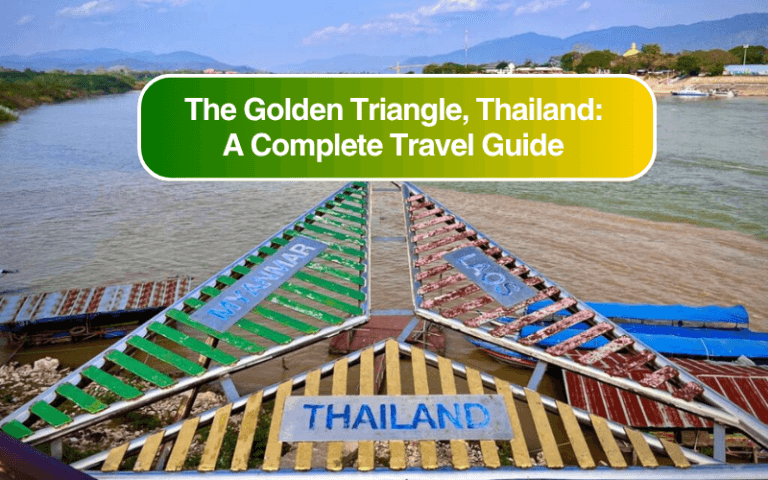
 19/11/2025
19/11/2025The Golden Triangle is one of the most legendary travel destinations in Southeast Asia, known for its history, stunning river landscapes, and multicultural influence

 08/10/2025
08/10/2025Discover Laos airports: 11 international & domestic hubs connecting travelers to Vientiane, Luang Prabang, Pakse, and nearby Southeast Asian countries.

 05/09/2025
05/09/2025Discover the Bolaven Plateau in southern Laos – explore stunning waterfalls, coffee plantations, local markets, and scenic loops with our complete travel guide
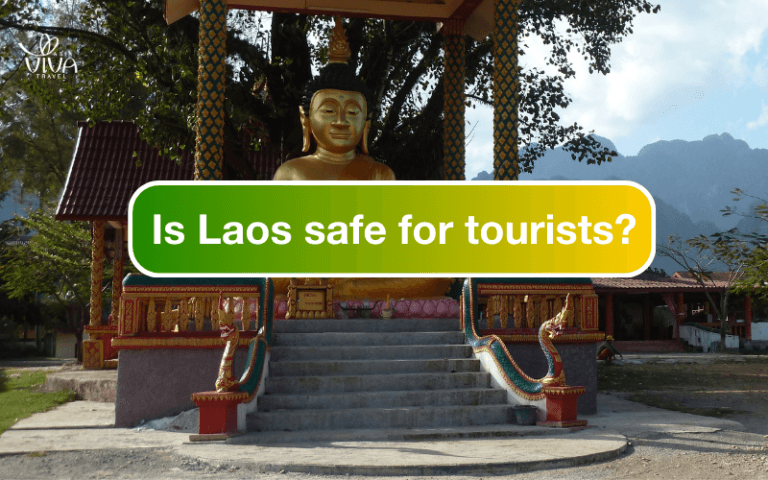
 11/08/2025
11/08/2025From peaceful temples to stunning nature, Laos safe to travel if travellers follow key safety tips. Don’t risk unexpected hassles, travel smart for a relaxing trip!